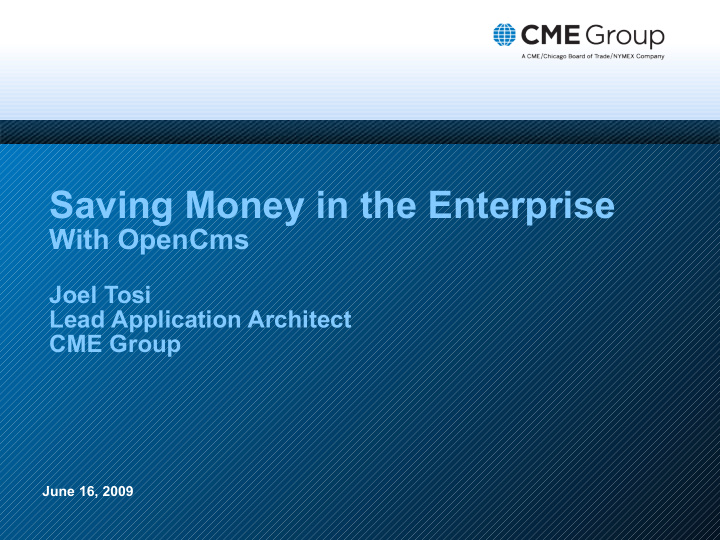



Saving Money in the Enterprise With OpenCms Joel Tosi Lead Application Architect CME Group June 16, 2009
Quick Overview Content • CME Background • Why OpenCms • What we are doing • Where are we going Format • Questions are good • My German ist nicht so gut
What is the Enterprise? • Large company – Defined by employees – Defined by $$$ – Defined by complexity • Pay for 'Enterprise Licenses' – 'Enterprise Support' – 'Quality' – ...Someone to blame 3
What is CME? • Background on CME • World's largest and most diverse derivatives exchange • Over 10 million contracts traded daily with notional value of hundreds of billions of dollars • cmegroup.com is the medium for marketing messages and data distribution • In 2006, purchased Chicago Board of Trade, 2008 purchased NYMEX with practically all operating cash (no debt) 4
Timewarp 2001 – Purchase of a licensed CMS Solution • • Percussion Rhythmyx v4.0 – List price of ~$500K (US) for one production license, one disaster recovery license, one QA license, and the 'developer studio' • License for version 4.x, future versions would cost additional – ~$80K (US) annually for support – Additionally budgeted on average $40K annually for consulting services – Required a dedicated Sun 440 Server for each environment ~ $10K (US) per server • Open Source solutions not even considered 5
cme.com ~2004
Environment Then Web/App Web/App Web/App Web/App CMS 7
Problems in Paradise • User interface was an applet • Support nightmare • Upgrades impossible • Slow • Pegged the server Support not very supportive • • Licensing 'disagreement' 8
The tides begin to turn - 2004 • We didn't have time for depth search • Tired of vendors and vaporware • Quick research based on our development standards (Java / XML) • Internal prototyping • Low risk, low entry point • Wanted an active community, stable product 9
Choice made, migration to OpenCms • Code was what we knew – Java, XML, XSD • Active Community • Mature Product • Had what we needed, didn't have what we didn't need, easily extensible • Ease of standing up • No 'weird errors' during smoke testing
Immediate cost savings (expected) Percussion OpenCms License $250K Free Support $80K $10K Services At least $40K if Varies based on we wanted to try needs and upgrade Hardware $40K (dedicated) $5K (shared) 11
Not just free licenses • Support – Average time to resolve a production impacting problem – 2 weeks (large sample set) – Average time with Open Source – 1 day – Higher quality, less defects – All adds up to $$$ savings • Bug Fixes / Release Schedule – Twice yearly releases, problematic bug fixes or 'pay for' – Nightly updates, fix it yourself – Its like CI for your software stack 12
More.... • Deployable / Installation base – Footprints • Transparency – Not sure what the code is doing? Debug it • Community 13
And still more... • Frees up developers • Allows us to do things we couldn't do before • Innovation - New ideas come to open source first 14
So Why OpenCms? • Its not just about licensing dollars
Cmegroup.com - 2009
CME Verizon FTP Data Clearing sFTP etc sFTP Historical Data PRS Regulatory EDB feedsEngine sFTP / rsync Clearing etc Content OpenCms sFTP EMC NAS Real-time CmeScheduler data (Delayed) Market Data Static content Cache Market Data Utility Bus Publisher MDP Lowest Bus MDP System Market Data Apache Cache http Customer Layer Request ftp Processor REST request Database Application DataParser rvrd Server Layer Market Data Client Bus Market Data Cache CheckPointe r 17 Database
CMS EMC Celerra RealTime Data Servers (Scaled to meet realtime needs , presumably at least 4 using Apache proxying for requests and load balancing ) Delayed Data (Scaled to meet realtime needs , presumably at Market Data Util Bus least 4 using Apache proxying for requests Market Data Cache and load balancing . Internet Portal Servers Web Servers (Cluster of servers Could sit with real time relative to subjects . and just be a function at CME Market Data (FIX / FAST) Currently this would be which case number of at least 14 servers, 7 for servers would be less data with redundancy ) than the total of 8 cumulative) Historical Data CME internal (Backend process application, updating tables, Connectable through portal application accessible as not services layer) portlet Historical Data services servers LDAP App Admin Servers / Backend Processing Education Environment
Thanks! • Joel Tosi – Lead Application Architect CME Group – Clojure, Scala, Ruby – Open Source, REST Services, NetKernel, TerraCotta – Agile Development – Joel.Tosi@cmegroup.com 19
Questions? 20
Recommend
More recommend